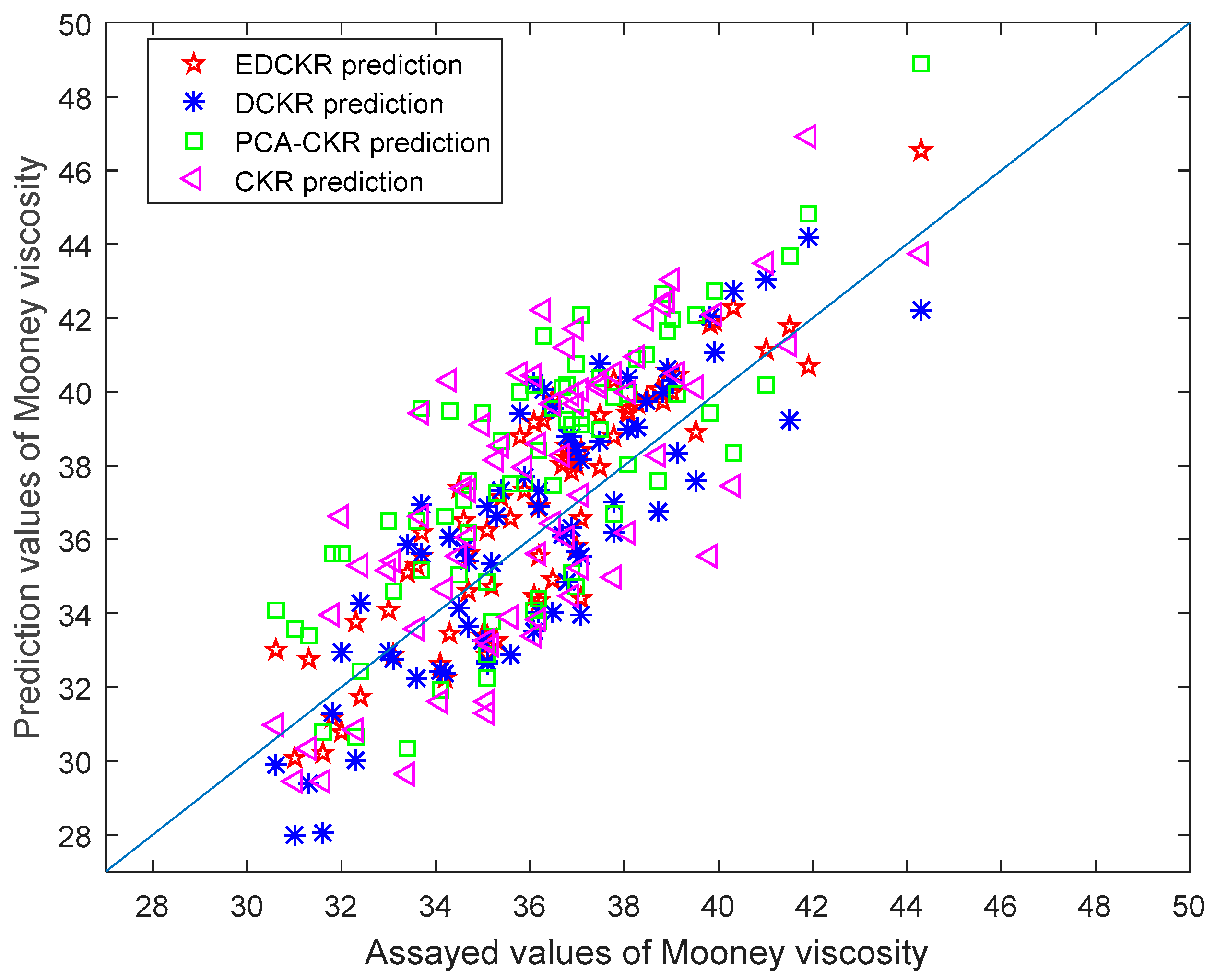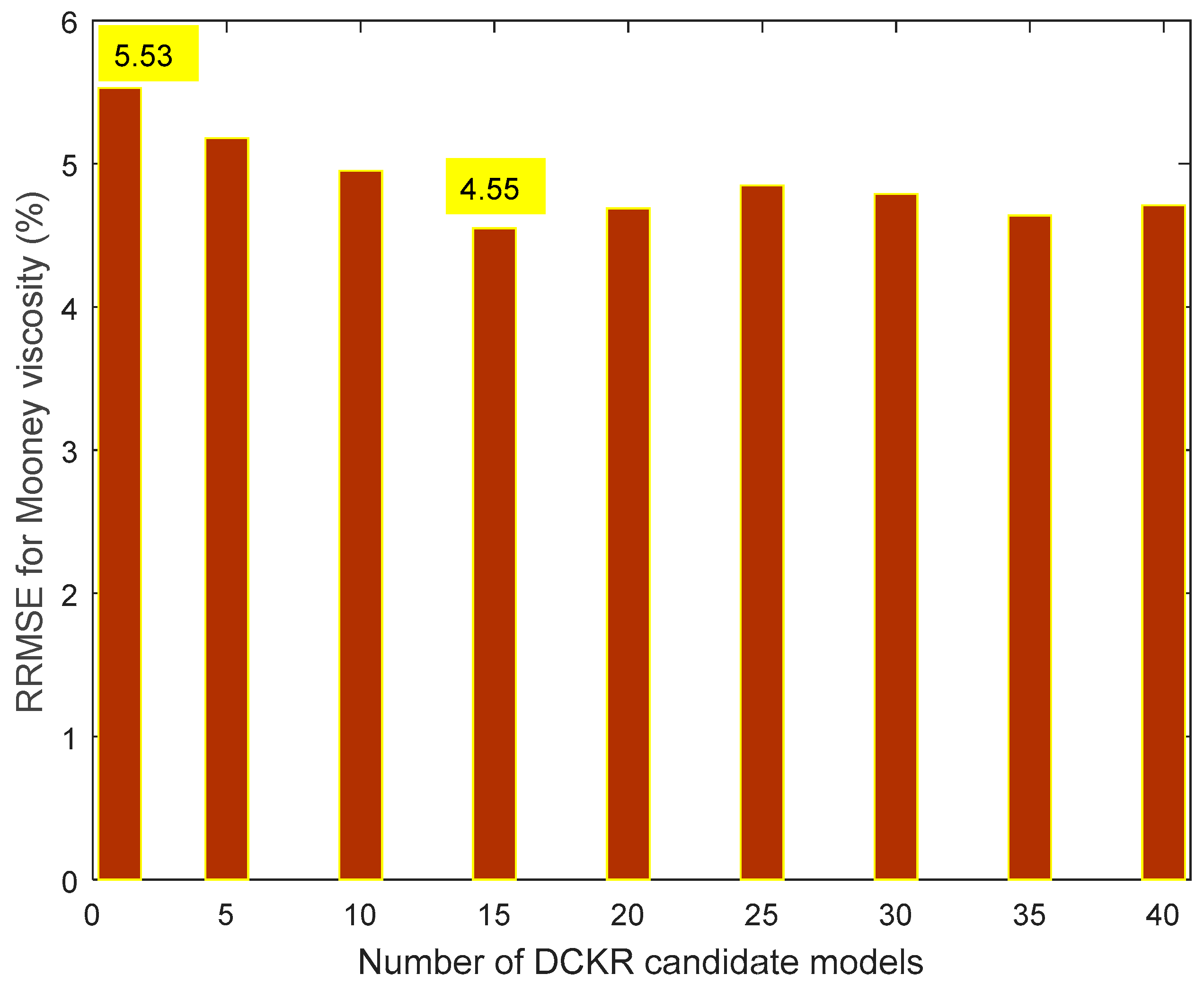Robust Soft Sensor with Deep Kernel Learning for Quality Prediction in Rubber Mixing Processes
Abstract
1. Introduction
2. Ensemble Deep Correntropy Kernel Regression Method
2.1. Restricted Boltzmann Machine Construction
2.2. Deep Correntropy Kernel Regression Model
2.3. Reliability Enhancement Using Bagging-Based Ensemble Strategy
3. Industrial Mooney Viscosity Prediction
4. Conclusions
Author Contributions
Funding
Conflicts of Interest
References
- Mark, J.E.; Erman, B.; Eirich, F.R. The Science and Technology of Rubber, 3rd ed.; Elsevier Academic Press: San Diego, CA, USA, 2005; p. 1395. [Google Scholar]
- Ehabe, E.; Bonfils, F.; Aymard, C.; Akinlabi, A.K. Sainte Beuve, Modelling of Mooney viscosity relaxation in natural rubber. Polym. Test. 2005, 24, 620–627. [Google Scholar] [CrossRef]
- Fortuna, L.; Graziani, S.; Rizzo, A.; Xibilia, M.G. Soft Sensors for Monitoring and Control of Industrial Processes; Springer Science & Business Media: Berlin, Germany, 2007. [Google Scholar]
- Kadlec, P.; Gabrys, B.; Strandt, S. Data-driven soft sensors in the process industry. Comput. Chem. Eng. 2009, 33, 795–814. [Google Scholar] [CrossRef]
- Ge, Z.; Song, Z.; Ding, S.X.; Huang, B. Data mining and analytics in the process industry: The role of machine learning. IEEE Access 2017, 5, 20590–20616. [Google Scholar] [CrossRef]
- Lu, B.; Chiang, L. Semi-supervised online soft sensor maintenance experiences in the chemical industry. J. Process Control 2018, 67, 23–34. [Google Scholar] [CrossRef]
- Fortuna, L.; Graziani, S.; Xibilia, M.G. Comparison of soft-sensor design methods for industrial plants using small data sets. IEEE Trans. Instrum. Meas. 2009, 58, 2444–2451. [Google Scholar] [CrossRef]
- Han, H.G.; Qiao, J.F. Prediction of activated sludge bulking based on a self-organizing RBF neural network. J. Process Control 2012, 22, 1103–1112. [Google Scholar] [CrossRef]
- Liu, Y.; Yang, C.; Liu, K.; Chen, B.; Yao, Y. Domain adaptation transfer learning soft sensor for product quality prediction. Chemom. Intell. Lab. Syst. 2019, 192, 103813. [Google Scholar] [CrossRef]
- Padmavathi, G.; Mandan, M.G.; Mitra, S.P.; Chaudhuri, K.K. Neural modelling of Mooney viscosity of polybutadiene rubber. Comput. Chem. Eng. 2005, 29, 1677–1685. [Google Scholar] [CrossRef]
- Marcos, A.G.; Espinoza, A.V.; Elías, F.A.; Forcada, A.G. A neural network-based approach for optimising rubber extrusion lines. Int. J. Comput. Integ. Manuf. 2007, 20, 828–837. [Google Scholar] [CrossRef]
- Zhang, Z.; Song, K.; Tong, T.P.; Wu, F. A novel nonlinear adaptive Mooney-viscosity model based on DRPLS-GP algorithm for rubber mixing process. Chemom. Intell. Lab. Syst. 2012, 112, 17–23. [Google Scholar] [CrossRef]
- Song, K.; Wu, F.; Tong, T.; Wang, X. A real-time Mooney-viscosity prediction model of the mixed rubber based on the independent component regression-Gaussian process algorithm. J. Chemom. 2012, 11, 557–564. [Google Scholar] [CrossRef]
- Jin, H.P.; Chen, X.G.; Wang, L.; Yang, K.; Wu, L. Adaptive soft sensor development based on online ensemble Gaussian process regression for nonlinear time-varying batch processes. Ind. Eng. Chem. Res. 2015, 54, 7320–7345. [Google Scholar] [CrossRef]
- Yang, K.; Jin, H.P.; Chen, X.G.; Dai, J.Y.; Wang, L.; Zhang, D.X. Soft sensor development for online quality prediction of industrial batch rubber mixing process using ensemble just-in-time Gaussian process regression models. Chemom. Intell. Lab. Syst. 2016, 155, 170–182. [Google Scholar] [CrossRef]
- Jin, W.Y.; Liu, Y.; Gao, Z.L. Fast property prediction in an industrial rubber mixing process with local ELM model. J. Appl. Polym. Sci. 2017, 134, 45391. [Google Scholar] [CrossRef]
- Zheng, W.J.; Gao, X.J.; Liu, Y.; Wang, L.M.; Yang, J.G.; Gao, Z.L. Industrial Mooney viscosity prediction using fast semi-supervised empirical model. Chemom. Intell. Lab. Syst. 2017, 171, 86–92. [Google Scholar] [CrossRef]
- Zheng, W.J.; Liu, Y.; Gao, Z.L.; Yang, J.G. Just-in-time semi-supervised soft sensor for quality prediction in industrial rubber mixers. Chemom. Intell. Lab. Syst. 2018, 180, 36–41. [Google Scholar] [CrossRef]
- Liu, Y.; Chen, J. Integrated soft sensor using just-in-time support vector regression and probabilistic analysis for quality prediction of multi-grade processes. J. Process Control 2013, 23, 793–804. [Google Scholar] [CrossRef]
- Liu, Y.; Chen, T.; Chen, J. Auto-switch Gaussian process regression-based probabilistic soft sensors for industrial multigrade processes with transitions. Ind. Eng. Chem. Res. 2015, 54, 5037–5047. [Google Scholar] [CrossRef]
- Lecun, Y.; Bengio, Y.; Hinton, G. Deep learning. Nature 2015, 521, 436–444. [Google Scholar] [CrossRef]
- Hinton, G.E. A practical guide to training restricted Boltzmann machines. Momentum 2010, 9, 599–619. [Google Scholar]
- Badar, M.; Haris, M.; Fatima, A. Application of deep learning for retinal image analysis: A review. Comput. Sci. Rev. 2020, 35, 100203. [Google Scholar] [CrossRef]
- Gao, X.; Shang, C.; Jiang, Y.; Huang, D.; Chen, T. Refinery scheduling with varying crude: A deep belief network classification and multimodel approach. AIChE J. 2014, 60, 2525–2532. [Google Scholar]
- Liu, Y.; Fan, Y.; Chen, J. Flame images for oxygen content prediction of combustion systems using DBN. Energy Fuels 2017, 31, 8776–8783. [Google Scholar] [CrossRef]
- Liu, Y.; Yang, C.; Gao, Z.; Yao, Y. Ensemble deep kernel learning with application to quality prediction in industrial polymerization processes. Chemom. Intell. Lab. Syst. 2018, 174, 15–21. [Google Scholar] [CrossRef]
- Wu, H.; Zheng, K.; Sfarra, S.; Liu, Y.; Yao, Y. Multi-view learning for subsurface defect detection in composite products: A challenge on thermographic data analysis. IEEE Trans. Ind. Inform. 2020. [CrossRef]
- Liu, Y.; Liu, K.; Yang, J.; Yao, Y. Spatial-neighborhood manifold learning for nondestructive testing of defects in polymer composites. IEEE Trans. Ind. Inform. 2020. [Google Scholar] [CrossRef]
- Xuan, Q.; Chen, Z.; Liu, Y.; Huang, H.; Bao, G.; Zhang, D. Multiview generative adversarial network and its application in pearl classification. IEEE Trans. Ind. Electron. 2019, 66, 8244–8252. [Google Scholar] [CrossRef]
- Xu, S.; Lu, B.; Baldea, M.; Edgar, T.F.; Wojsznis, W.; Blevins, T.; Nixon, M. Data cleaning in the process industries. Rev. Chem. Eng. 2015, 31, 453–490. [Google Scholar] [CrossRef]
- Liu, Y.; Chen, J. Correntropy kernel learning for nonlinear system identification with outliers. Ind. Eng. Chem. Res. 2014, 53, 5248–5260. [Google Scholar] [CrossRef]
- Liu, Y.; Fan, Y.; Zhou, L.C.; Jin, F.J.; Gao, Z.L. Ensemble correntropy-based Mooney viscosity prediction model for an industrial rubber mixing process. Chem. Eng. Technol. 2016, 39, 1804–1812. [Google Scholar] [CrossRef]
- Zhu, J.; Ge, Z.; Song, Z.; Gao, F. Review and big data perspectives on robust data mining approaches for industrial process modeling with outliers and missing data. Annu. Rev. Control 2018, 46, 107–133. [Google Scholar] [CrossRef]
- Shao, W.; Ge, Z.; Song, Z.; Wang, J. Semi-supervised robust modeling of multimode industrial processes for quality variable prediction based on Student’s t mixture model. IEEE Trans. Ind. Inform. 2020. [Google Scholar] [CrossRef]
- Zhou, Z.H.; Wu, J.X.; Tang, W. Ensembling neural networks: Many could be better than all. Artif. Intell. 2002, 137, 239–263. [Google Scholar] [CrossRef]
- Liu, W.; Pokharel, P.P.; Principe, J.C. Correntropy: Properties and applications in non-gaussian signal processing. IEEE Trans. Signal Process. 2007, 55, 5286–5298. [Google Scholar] [CrossRef]
- Chen, T.; Ren, J.H. Bagging for Gaussian process regression. Neurocomputing 2009, 72, 1605–1610. [Google Scholar] [CrossRef]
- Tang, J.; Chai, T.; Yu, W.; Zhao, L. Modeling load parameters of ball mill in grinding process based on selective ensemble multisensor information. IEEE Trans. Autom. Sci. Eng. 2013, 10, 726–740. [Google Scholar] [CrossRef]
- Jin, H.; Pan, B.; Chen, X.; Qian, B. Ensemble just-in-time learning framework through evolutionary multi-objective optimization for soft sensor development of nonlinear industrial processes. Chemom. Intell. Lab. Syst. 2019, 184, 153–166. [Google Scholar] [CrossRef]




| Mooney Viscosity Soft Sensor | Main Characteristics | RRMSE (%) | Maximum Absolute Error | |
|---|---|---|---|---|
| Model Structure | Feature Extraction | |||
| EDCKR (proposed) | deep (multiple) | nonlinear | 4.55 | 3.28 |
| DCKR (proposed) | deep | nonlinear | 5.53 | 4.16 |
| PCA-CKR | shallow | linear | 7.71 | 5.86 |
| CKR [32] | shallow | no | 8.10 | 5.99 |
© 2020 by the authors. Licensee MDPI, Basel, Switzerland. This article is an open access article distributed under the terms and conditions of the Creative Commons Attribution (CC BY) license (http://creativecommons.org/licenses/by/4.0/).
Share and Cite
Zheng, S.; Liu, K.; Xu, Y.; Chen, H.; Zhang, X.; Liu, Y. Robust Soft Sensor with Deep Kernel Learning for Quality Prediction in Rubber Mixing Processes. Sensors 2020, 20, 695. https://doi.org/10.3390/s20030695
Zheng S, Liu K, Xu Y, Chen H, Zhang X, Liu Y. Robust Soft Sensor with Deep Kernel Learning for Quality Prediction in Rubber Mixing Processes. Sensors. 2020; 20(3):695. https://doi.org/10.3390/s20030695
Chicago/Turabian StyleZheng, Shuihua, Kaixin Liu, Yili Xu, Hao Chen, Xuelei Zhang, and Yi Liu. 2020. "Robust Soft Sensor with Deep Kernel Learning for Quality Prediction in Rubber Mixing Processes" Sensors 20, no. 3: 695. https://doi.org/10.3390/s20030695
APA StyleZheng, S., Liu, K., Xu, Y., Chen, H., Zhang, X., & Liu, Y. (2020). Robust Soft Sensor with Deep Kernel Learning for Quality Prediction in Rubber Mixing Processes. Sensors, 20(3), 695. https://doi.org/10.3390/s20030695






